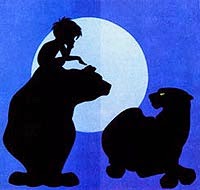In Part Two we addressed why the man’s
“suitable partner” had to be made from his very substance, and not, like him,
scooped from the ground then enlivened with divine breath. In this bite-size
piece we’ll contemplate the man’s reaction to his partner, and the implication
expressed by the author of Genesis.
“This
one, at last, is bone of my bones and flesh of my flesh; this one shall be
called ‘woman,’ for out of ‘her man’ this one has been taken.”
That
is why a man leaves his father and mother and clings to his wife, and the two
of them become one body. (Genesis
2:23-24)
Why does the man need a partner in the
first place? Because he is the image of God; since God is love, the man needs
someone to love in order to be this divine image.
The animals were unsuitable partners not
only because they were created apart from the man’s substance, but because they
did not possess the breath of divine life. The man cannot complete the divine
image with an animal. Since the woman has proceeded from the man she is
consubstantial, both body and spirit, and is thus his equal.
The man joyfully expresses, first of
all, the woman’s equality with him.
“This
one, at last, is bone of my bones and flesh of my flesh; this one shall be
called ‘woman,’ for out of ‘her man’ this one has been taken.”
But there’s more. The man’s fascination
with the woman’s body is significant--it is very different from modern man’s
fascination with a woman’s body!
At this point the man and woman do not
know sin; their vision is perfectly clear, not clouded by sinful inclinations
and selfish desires. They see in each other’s bodies nothing but the beauty and
glory of God--and the incredible privilege they have been granted to love each other with their bodies as
God loves.
That’s the fascination, that’s the
excitement. They see in their genitals the gift to be joined as one body in a
life-giving union--an image of the Holy Trinity--and this fascinates and
excites them.
The
man and his wife were both naked, yet they felt no shame. (Genesis 2:25)
The man in this original state of
innocence could not be excited by the body of another man, for he could not be
joined to another man as one fruitful body imaging the love of the Holy Trinity.
The woman cannot do this with another woman.
For two persons made from the same
substance to be joined as one, they have to be fashioned with complimentary
bodies--which is why God created them so, with an innate yearning to be joined
to each other.
For that union to image the Trinitarian
God whose union of persons in love is free, total, faithful and fruitful, human
sexual union has to be all of those. Anything short of that fails to image God
who created human sexuality in the divine image.
That
is why a man leaves his father and mother and clings to his wife, and the two
of them become one body.
So what went wrong? We’ll examine this
in Part Five.
